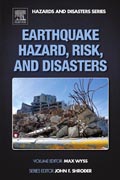
Earthquake Hazard, Risk and Disasters presents the latest scientific developments and reviews of research addressing seismic hazard and seismic risk, including causality rates, impacts on society, preparedness, insurance and mitigation. The current controversies in seismic hazard assessment and earthquake prediction are addressed from different points of view. Basic tools for understanding the seismic risk and to reduce it, like paleoseismology, remote sensing, and engineering are discussed. Contains contributions from expert seismologists, geologists, engineers and geophysicists selected by a world-renowned editorial boardPresents the latest research on seismic hazard and risk assessment, economic impacts, fatality rates, and earthquake preparedness and mitigationIncludes numerous illustrations, maps, diagrams and tables addressing earthquake risk reductionFeatures new insights and reviews of earthquake prediction, forecasting and early warning, as well as basic tools to deal with earthquake risk INDICE: 1. Protocols for developing imagery-based preliminary damage assessments 2. Earth observation for earthquake risk and damage assessment 3. Disaster risk reduction through the training of masons and public information campaigns: Experience of SDC's Competence Centre for Reconstruction in Haiti 4. The most useful countermeasure against giant earthquakes and tsunami: What we learned from interviews of 164 tsunami survivors 5. Earthquake risk in SE Asia: Engineering vs human nature 6. Estimating seismic losses in real time and for future disasters 7. Forecasting seismic risk as an earthquake sequence progresses 8. How to render schools safe in developing countries 9. The socioeconomic impact of earthquake disasters 10. The contribution of paleoseismology to earthquake hazard evaluations 11. The role of microzonation in estimating earthquake risk 12. Why the standard probabilistic methods of estimating seismic hazard and risks are too often wrong 13. The ongoing practical benefits of probabilistic seismic hazard assessment 14. Precarious rocks providing upper limits on past ground shaking from earthquakes 15. Quantifying Improvements in earthquake hazard estimates through testable models 16. Duties of earthquake forcasting 17. The experience of real time earthquake predictions on Kamchatka 18. Times of increased probabilities for the occurrence of catastrophic earthquakes: 25 years of the hypothesis testing in real time 19. Review of the nationwide earthquake early warning in Japan during its first five years 20. To what extent can engineering reduce the seismic risk? 24. Decision making under uncertainty: Insuring and reinsuring earthquake risk
- ISBN: 978-0-12-394848-9
- Editorial: Academic Press
- Encuadernacion: Cartoné
- Páginas: 400
- Fecha Publicación: 27/07/2014
- Nº Volúmenes: 1
- Idioma: Inglés
